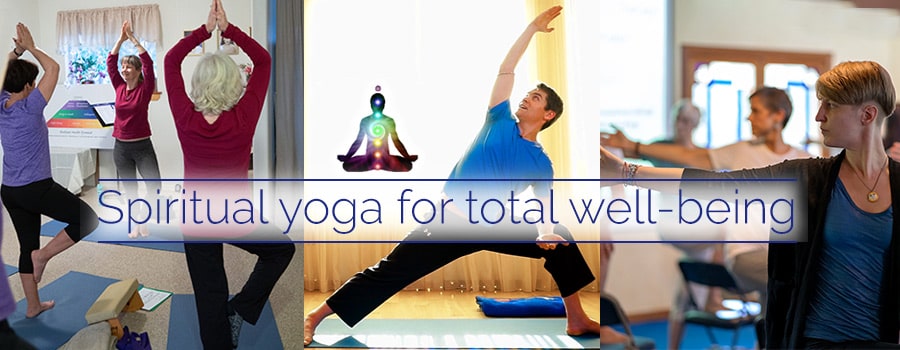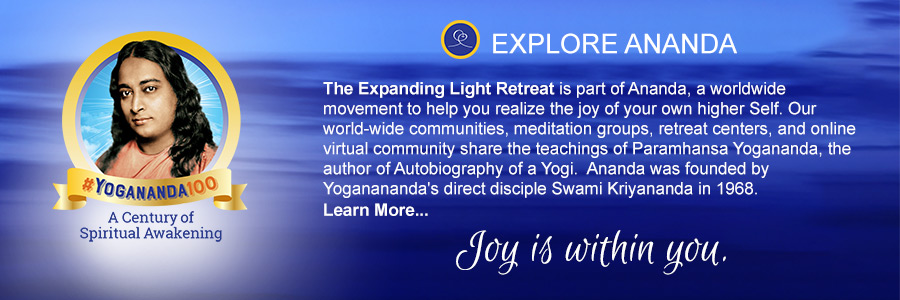What is Ananda Yoga?
This article was written for the Ananda Yoga® Teacher Association newsletter.
Learn more, or find a certified Ananda Yoga® teacher near you.
Download PDF (50kb)
Although written for Ananda Yoga teachers, this article will interest any serious practitioner of yoga.
What do you say when someone asks, “What is Ananda Yoga?” Probably you give a brief and rather general answer, tailored to what you think he or she will best relate to. But what is Ananda Yoga, really?
There’s no quick, definitive answer, but in this article I’ll highlight the essence of it. I hope it will help your teaching as well as your practice. You might even find a surprise or two.
It’s not a list of asanas
First, I’d like to banish a common misconception: Ananda Yoga is not limited to the asanas mentioned in The Art and Science of Raja Yoga, or even in my new, expanded book, Spiritual Yoga: Higher Awareness through Ananda Yoga (to be published in 2013). A list of “permissible” postures would be a nice, easy definition of Ananda Yoga, but it would miss the point. Swamij doesn’t work that way. He’s often said that his work is seminal. In the many topics he’s addressed—education, meditation, leadership, relationships, Ananda Yoga, etc.—he’s established a framework and a direction, but left it to others to continue that direction, expand upon what he’s said, and apply it in many practical arenas.
Similarly, Ananda Yoga Teacher Training is a seminal training: we explore a well rounded set of asanas that you can teach to most students, but that set of asanas is, by necessity, limited. Our hope is that the training will enable you to expand on that set, to understand and teach other asanas from the Ananda Yoga perspective.
On the other hand …
That doesn’t mean that “anything goes” in Ananda Yoga—or in any genuine tradition, for that matter. That would be chaos, which I think accurately describes the current American yoga scene. In the name of freedom, many teachers have committed themselves to eclecticism, lumping together techniques and approaches from many different traditions.
When I remarked on this once—while rolling my eyes, I admit—someone challenged me rather sharply, “What’s wrong with that?!” I replied, “Nothing, except that it has no power.” (I could have added: “… and it causes spiritual indigestion.”) True yoga is not just a collection of techniques; a genuine yoga tradition holds to a specific ray of divine light because that ray is the source of its power. Only certain things are done, and they are done in a certain way—not out of dogmatism or rigidity, but because that’s how one can best tune in to that particular ray. Spreading oneself over multiple traditions inevitably results in being unable to go deep in any of them.
Many people don’t like to hear this, thinking that it limits their freedom. But as a chiropractor once said when I complained about what he said I should and should not do, “Hey, I don’t make the rules!” In Hatha Yoga, eclecticism may be fine if all one seeks is a physical workout, but “the rule” is that it takes focus and “tuning in” to attain the highest.
The January 2001 issue of Yoga International (now Yoga+Joyful Living) reinforced this point:
“The instructions [from the teacher] must flow from a genuine tradition, and you need to remain with the teacher who is fully connected to the tradition. If you are still working on the preparatory steps … it is all right to shop around. But if you wish to discover the inner dimensions of yoga that guarantee everlasting peace and happiness, you must study under the guidance of an experienced teacher and follow their instructions precisely.”
The central goal
How does this apply to Ananda Yoga? In describing his thought process in developing Ananda Yoga based on his training with Paramhansa Yogananda, Swami Kriyananda has said:
“Yoga’s purpose is spiritual, and since Hatha Yoga is the physical branch of Raja Yoga, it must have a spiritual purpose. It can’t be just to give you a good body. …
“As I meditated on it, I realized that there is a very close connection between the positions of the body and the attitudes of the mind, and also of the soul. For example, a spiritual attitude is going to make you graceful, not awkward or hasty. It will lead you to relaxation, not tension. I also thought about how to use the postures to advance the purpose of the foundation of Hatha Yoga, which is Raja Yoga: to awaken the energy, loosen the spine so the energy can reach the brain more easily, bring it up the spine to the brain, and give you the experience of centeredness and upliftedness.”
That’s the key. Ananda Yoga is not just about getting “a good buzz,” as one person put it while enthusing about a particular technique. It’s about generating a powerful inward and upward flow of energy in a safe, balanced way.
Therefore, every part of Ananda Yoga—including and especially one’s attitude—should contribute to this goal. All else is distraction (or worse). And yes, that means that some yoga practices—certain asanas and pranayamas, combining active asanas with pranayamas, nearly all “flows” (vinyasas)—don’t fit within Ananda Yoga. It’s not because they’re “bad” in some way; it’s because they don’t harmonize with the rest of Ananda Yoga to take us toward this goal.
Contributors to the goal
But let’s focus on what does fit. Consider, for example, how some familiar aspects of Ananda Yoga take us toward the goal:
Energization Exercises: Mastering Energization takes our practice to an entirely new level. It’s the technique par excellence for increasing energy and our awareness of it. Only with awareness can we draw energy inward and upward—without awareness, all the energy in the world won’t do us much good. Energization also prepares our nervous system to handle more and more energy. It’s a prime contributor to the overall goal. The more I teach Ananda Yoga—and hear from others who teach it—the more I see how valuable Energization is.
Sequence: Ananda Yoga routines are sequenced to bring energy inward and upward. Standing asanas come first, to center our awareness in the spine, stimulate vitality, and begin to tune in to energy. Then we move to a variety of floor poses, designed to release energy from the extremities, stretch and open the spine, and charge the spine with energy. Inverted poses follow, to draw the awakened energy to the brain with the aid of “subtle gravity.” Deep relaxation in Savasana then helps us internalize this energy in the brain (pratyahara, in Patanjali’s Ashtanga Yoga). Finally, meditation, the pinnacle of the practice, brings energy to the spiritual eye and lifts consciousness in a way that no other practice can.
Continuous awareness: We move slowly, smoothly and consciously into and out of the asanas, so as not to diminish or interrupt our awareness of energy flows generated through the asanas. A continuous awareness of the spine—using it consciously at all times, and keeping it well supported—is central to this. Moving in this way increases both our awareness of energy and its ability to move freely through the spine. Similarly, in the deeper practice we never strain in the asanas, because that would diminish both the energy flow and our awareness of it. Work, yes; strain, no.
Pauses: Why do we pause in a “neutral” pose between “active” poses (e.g., in Tadasana after Utkatasana or each side of Trikonasana)? It’s certainly different from much of the Hatha Yoga one sees these days, which leans heavily in the direction of vinyasa practice.
Swami Kriyananda was blunt when I asked him about this trend: “It’s not good yoga. If you hold a position, that’s when you can get into the consciousness behind that position. Constant motion isn’t the answer. It just becomes calisthenics. Ours is a path of constantly coming back to the center, to the spine. That’s the core of it, and you can’t do that if you’re always moving from one asana to the next. The time between [active] poses is very important.”
So the pause is not just to rest; it’s to work with energy and consciousness to assimilate the benefits of the preceding pose, internalize awareness, and lift the awakened/freed energy toward the brain. We would lose this opportunity if we moved into the next active asana without pausing. The neutral pose is, to a great extent, the completion of the preceding active pose, as well as preparation for the next one.
What about the affirmations?
If there’s one thing that’s unique about Ananda Yoga, it’s asana affirmations. It’s tempting to say, “Ah, here’s something definitive: without affirmations, it’s not Ananda Yoga.” Well, Swami Kriyananda doesn’t view it that way:
“Obviously, the center of Ananda Yoga is not the fact of having affirmations. The center of Ananda Yoga is the way in which it helps our meditation, our stillness. I can see how people might resist doing [asana affirmations] and still feel they were working with the energy and so on. Nonetheless, they’re a good thing, and they do help your consciousness.”
So it’s not a question of whether we can do Ananda Yoga without affirmations. The real question is, What leads us most quickly to our goal? Whatever that is, we’ll do it if we’re serious about the goal. Affirmations are not the goal; raising consciousness is the goal. Affirmations are a means to that goal; as Swami put it, “they do help your consciousness.” That’s why it’s clear to me that a serious Ananda Yogi will want to use the affirmations. Certainly anyone who is officially representing Ananda—e.g., teachers at The Expanding Light retreat center or other Ananda centers and meditation groups—should do so.
Remember, an affirmation is not an attempt to define (and therefore limit) our experience of an asana; it’s a tool for attuning ourselves to the essence of the asana, and more important, to a particular state of consciousness. In the beginning of one’s practice, we might simply repeat the affirmation over and over, trying somehow to “catch the wave.” But our use of the affirmation will evolve as our practice deepens.
My own approach has long been like this: Over a long period (weeks, even months) of initial work with a particular asana, the affirmation helps guide me to a more intuitive, more “feeling” understanding of the asana. As my understanding grows, I’ll repeat the affirmation less—eventually just once or twice, to give direction to my efforts to tune in to the effects of the asana on my consciousness. It’s not the affirmation that takes me deep into that essence; it’s my feeling capacity, guided by and aided by the affirmation.
It’s as though the affirmation guides me through a doorway into a deeper experience of the asana. Once I’m through the doorway, I don’t need the affirmation anymore; I return to it only if my attention wanders. But make no mistake: it takes focus to open the door, and I’ve found Swamiji’s affirmations invaluable for that.
In teaching classes, I encourage use of the affirmations because they help students break the hypnosis of physicality, begin to understand the asanas, and bring their energy inward and upward. A few get it right away; many take longer. When their practice deepens—as it inevitably does if they persist—I advise them to let their feeling nature take over so that they may go deeper still (but as I said, not to discard the affirmation entirely).
Don’t hold back—give the highest
Yes, it’s harder to teach this way than to teach yoga for exercise, relaxation, stress relief, or just recreation—all of which are perfectly fine; it’s just that Ananda Yoga has a higher aim. As one experienced vinyasa yoga teacher once put it after he graduated from Ananda Yoga Teacher Training and began to teach Ananda Yoga: “I don’t know what ever led me to believe I could do this!” I applauded him for recognizing that Ananda Yoga isn’t just slapping affirmations on the poses. It takes a strong personal practice and creative personal understanding to learn to convey the subtler aspects of the practice: working with energy and consciousness. But it’s very doable, and a wonderful way to express and build your creativity. (And it’s something we look for in the final practicum for Level 2 Ananda Yoga teacher certification.)
The Ananda YTT staff are always available to help our graduates with this, any of whom already know enough to experiment with it. You’ll inevitably try some things that don’t work, are too vague or flaky, are too complicated, are beyond your own understanding, are not comprehensible for your students, etc. No matter. Just keep trying. It takes time to learn, but the benefits are astonishing—for both teacher and students.
Certainly it’s easier for those who live in or near an Ananda community, where the subtler aspects are constantly being discussed, experimented with, and lived. Those of you who are relatively alone don’t have that kind of in-person support. But I’ve seen many times that it’s doable for anyone who simply decides to do it, and not to let their practice and teaching stay on a more mundane level of straining, stretching, relaxing, pushing, etc. That decision is the doorway to teaching and practicing true Ananda Yoga.
The role of meditation
So far I’ve emphasized the asana aspect of Ananda Yoga, but what about meditation? In most yoga traditions, meditation is strictly separate from the hatha component—if indeed, the tradition even has a hatha or meditation component. Many traditions view hatha solely as a precursor to meditation, a way to harness restless energy and prepare the body to sit. Once hatha practice has made a person ready for meditation, asanas will no longer be part of his or her future sadhana (spiritual practice).
However, meditation is an integral part of Ananda Yoga from the outset of one’s practice. Furthermore, asana practice can also be very beneficial after a person has established a deep, regular meditation practice. It’s true that all great yogis reach the stage where hatha practice falls away. As Yoganandaji put it in Autobiography of a Yogi, “[hatha] yoga is little used by yogis bent on spiritual liberation.” But until that time, asanas can do much more than prepare the body to sit: The deeper practice, which we emphasize in Ananda Yoga, will raise our consciousness and make meditation even more productive.
The ultimate criterion
Above all, what really defines Ananda Yoga is the vibration and spiritual power of Paramhansa Yogananda. Earlier I said that each yoga tradition is a “specific ray of divine light.” In Ananda’s case, that ray comes through Yoganandaji. You experience that ray when you take Ananda YTT. Swami Kriyananda drew upon that ray in order to develop Ananda Yoga. When I asked Swamiji how to be the best Ananda Yoga teachers we can be, his answer was basically, “Tune in to Master [Yoganandaji].”
It doesn’t matter whether you are his disciple. Great masters will aid anyone who tunes in to them. If you truly want to feel and teach the essence of Ananda Yoga, call upon Paramhansa Yogananda. Ask for his guidance, and try to tune in to his consciousness—and as I said, we on the Ananda YTT staff are here to help you. As you continue and refine your efforts, you’ll become ever clearer as to the essence of Ananda Yoga and this spiritual tradition, and how to convey it to others.
Related Articles
- What is Ananda Yoga? (For yoga students)
All authors are graduates of Ananda Yoga Teacher Training.





















